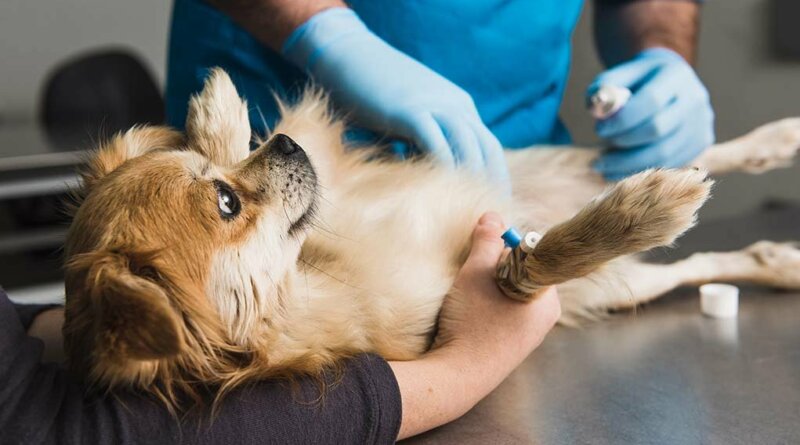22 Signs and Symptoms That Require an Immediate Vet Visit – Top Dog Tips
In most cases, if your dog looks like they need urgent medical attention, it is probably so. Some apparent medical conditions always require care at a veterinary practice, and you as the owner must ask for help immediately after noticing the signs.
However, the problem is when symptoms are not visible at first glance, even if the animal is in a life-threatening situation. Here is a list of the most severe signs and symptoms that require an immediate vet visit.
1. Difficulty Breathing
If there is the most urgent case that requires emergency veterinary care, it is certainly a difficulty in breathing. Once the dog stops breathing, you do not have more than three minutes to do something before it gets too late.
Any breathing issues in dogs, unusual breathing, alarming noises while breathing or swollen lips requires you to seek the assistance of a vet immediately.
Also, it is crucial to pay attention to symptoms such as coughing, wheezing, choking, and shallow breathing. They can alert you that the dog has a foreign body in the throat or elsewhere, allergy, asthma, as well as lung or heart disease.
2. Coughing
A dog coughing is one of those states that may or may not require veterinary help. The cause can be something relatively harmless such as benign kennel cough. However, since there are more severe causes of coughing in dogs, such as pneumonia, it is better for you to visit the vet just in case.
3. Neurological Disorder
Neurological disorders are a result of the problem with the dog’s brain, nerves, and/or spinal cord. Depending on the cause, the symptoms of neurological problems in dogs can be lethargy, incoordination, walking in circles, seizures, tremors, facial paralysis, and blindness.
There is no need to stress the importance of the appointment with the vet in such a situation – it’s apparent.
4. Epileptic Seizure
There is no reason for you to panic if the dog has had a single seizure episode. However, if the condition comes in clusters and becomes progressive, it is necessary to treat that condition as life-threatening and it’s time to ask for help as soon as possible.
Among the many potential causes of seizures in dogs, the most severe are toxins, medications, and head trauma.
5. Weakness and Collapse
In some cases, these symptoms appear when the dog has other more serious health problems, such as:
Most of these issues can be life-threatening and require emergency veterinary assistance.
6. Profuse Bleeding
Profuse hemorrhage is always an emergency condition requiring immediate veterinary care. It is necessary to take your dog to the vet if they fell from a height, got wounded in a fight with other dogs, or if they were hit by a car.
After a detailed examination, it is possible the vet will find internal injuries or bleeding, which are not visible to you at first glance but are life-threatening to the dog.
7. Significant Trauma
In a situation of significant trauma, particularly with broken bones and/or open wounds, there is no need for too much explaining. After an accident or other similar injury, there is no other solution than to ask your veterinarian for help. The same applies to cases of bleeding from the dog’s eyes, mouth, or nose.
8. Severe Pain
Any acute pain in the dog is always an emergency condition without any exceptions. If your pet all of a sudden starts constantly whining, shaking, and limping, or shows other signs of pain or agony, they need urgent veterinary treatment and to be administered strong pain killers.
9. Seized Hind Legs
So-called chondrodysplastic dog breeds with long backs and short legs may suffer from a sudden loss of use of hind legs. In most cases, it is a genetic skeletal disorder or the consequence of the injury to the dog’s spinal cord.
Regardless of whether paralysis is complete or partial, the condition is excruciating for your pet. Therefore, starting with treatment as soon as possible may make a big difference in the outcome of this severe condition.
10. Dragging the Rear Part of the Body
If your dog begins dragging or scooting their rear part of the body on the floor, they are probably suffering from worms, an infection of the urinary tract, infected or blocked anal glands, or diarrhea. Since you won’t know what the exact cause of this is, you’ll need to bring your pooch to see a veterinarian.
11. Sluggishness and Fatigue
When a normally happy and playful dog suddenly becomes lethargic, it may have a problem with sore muscles, pain, or high temperatures. When that condition lasts more than two days, it is necessary to visit your veterinarian.
12. Poisoning
If there is the slightest suspicion that your dog is poisoned, they should be taken to the vet before the seizures or other symptoms start.
The most common exposures include rodent bait, slug poisons, grapes, raisins, chocolate, as well as an overdose with human or flavored canine medications. In such situations, full recovery is possible when immediate treatment is provided, before the toxin is digested.
13. Allergic Reactions
The most common allergic reactions in dogs are anaphylaxis, face or throat edema, urticaria, and allergic dermatitis. The most severe cases occur after the sting of wasps and hornets followed by swelling of the airway, breathing difficulty, hives, diarrhea, and shock. If therapy is not started immediately, there is a real possibility of a fatal outcome.
14. Red or Cloudy Eyes
Changes in the condition of your dog’s eyes such as cloudiness, swelling, redness, itching, and excessive discharge usually indicate an injury and eye infection. To avoid possible blindness, taking the dog for an immediate vet checkup is a necessity.
15. Bloat (Gastric Dilatation-Volvulus)
The restless and breathless dog that tries but can’t vomit, and has abdominal swelling, probably has a condition called canine bloat (Gastric Dilatation-Volvulus). GDV is a severe life-threatening state commonly affecting large dog breeds. To increase the possibility of full recovery, taking your dog to the vet right away is required.
16. Long-term Vomiting Followed by Diarrhea
If the dog has eaten something inappropriate, they may vomit or suffer from a bout of diarrhea for a day. However, if that condition lasts longer than twenty-four hours, especially if it is followed by bloody stool, it is necessary to take this condition far more seriously.
Repeated vomiting and diarrhea that lasts longer than a day and is followed with a fever always leads to dehydration, and this life-threatening state requires professional help.
17. Unusual Stool
A dog’s stool is an excellent indicator of its overall health. Any changes, including worms, mucus, or blood in the stool, are a warning sign. Such a condition needs to be treated as a medical emergency and requires an immediate visit to the veterinarian.
18. Sudden Weight Loss
Quick and unexpected weight loss may indicate a severe health issue in your dog, so visiting a vet is required. Every sudden drop in weight by 10% should be taken seriously. It is a big deal particularly for small dogs, where the weight loss of just 1 pound (0.45 kg) is a good reason to worry.
19. Difficulty Urinating
In most cases, this condition means that the dog has a bladder infection. Even though this issue is highly painful, it is not life-threatening. On the other hand, your dog’s difficulty in urinating can be a symptom of bladder stones obstructing the urinary tract. When it comes to blockage, the only way to help your dog is proper veterinary care.
20. Excessive Thirst
Occasionally, dogs may drink more than normal. However, if your dog keeps asking for more water than usual on a continuous basis, it may be a condition called Polydipsia and it’s likely caused by diabetes or kidney disease. To eliminate the harmless, currently increased thirst, consultation with the vet is necessary.
21. Refusing to Eat or Drink
There is no need to panic if the dog skips one or even two meals. However, when your pooch avoids eating for more than a day, it is most likely because they’re ill. If the dog also refuses water, this is far more dangerous because the condition will lead to dehydration. In such a situation, visiting your vet is a must.
22. Dry and Rough Fur
A fur of a healthy dog is shiny, thick, and soft. Once it becomes dull, dry, and rough with bald patches, this is an indication that something is wrong. The common reasons are skin diseases, inadequate food or improperly balanced diet, and allergies. In any case, an appointment with the vet is highly recommended.
READ NEXT: 25 Most Serious Dog Health Symptoms That Cannot Be Ignored




over the counter cough medicine: over the counter acne treatments is ivermectin over the counter
Gdy zapomnisz hasła do zablokowania ekranu, jeśli nie wprowadzisz prawidłowego hasła, odblokowanie i uzyskanie dostępu będzie trudne. Jeśli okaże się, że Twój chłopak / dziewczyna jest podejrzana, być może pomyślałeś o włamaniu się do jego telefonu Samsung, aby uzyskać więcej dowodów. Tutaj zapewnimy Ci najlepsze rozwiązanie, jak złamać hasło telefonu komórkowego Samsung.